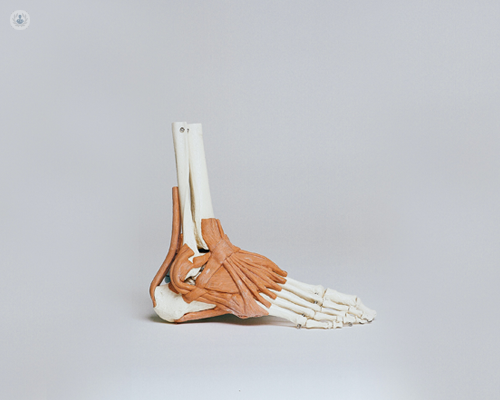Ankle arthritis treatment options: When is surgery needed?
Written by:Ankle arthritis can significantly affect a person’s mobility and quality of life. While conservative treatments can provide relief for many, surgical options like ankle replacement and ankle fusion offer potential solutions for more severe cases.

What is ankle arthritis?
Ankle arthritis refers to the inflammation and deterioration of the ankle joint, which can lead to pain, swelling, stiffness, and reduced range of motion. These symptoms can significantly affect daily activities and overall quality of life.
Ankle arthritis can be classified into different types according to their causes:
- Osteoarthritis: This is the most common type and occurs when the cartilage that cushions the ankle joint wears down over time. This degeneration results in bone-on-bone contact, causing pain and stiffness.
- Rheumatoid arthritis: This autoimmune condition occurs when the body's immune system attacks the lining of the ankle joint, causing inflammation and damage to the joint.
- Post-traumatic arthritis: This condition develops after an injury to the ankle joint, such as a fracture or severe sprain, which can lead to cartilage damage and arthritis over time.
When is surgery considered for ankle arthritis?
Surgery for ankle arthritis is typically considered when non-surgical treatments have failed to provide sufficient relief and the condition is significantly affecting quality of life. Surgery may be recommended if:
- The pain is persistent and debilitating despite medications, physiotherapy, and other conservative treatment.
- The arthritis severely limits movement or function in the ankle, affecting daily activities and quality of life.
- The arthritis has caused significant joint damage or deterioration which affects the ankle’s function.
What is an ankle replacement?
Ankle replacement, also known as total ankle arthroplasty, is a surgical procedure designed to replace a damaged or arthritic ankle joint with an artificial implant. This operation is typically performed under general anaesthesia.
During ankle replacement surgery, your orthopaedic surgeon will make an incision near the ankle joint to excise the damaged cartilage and bone. Following this, an artificial implant, often made from metal and plastic components, will be inserted into the prepared joint space to replicate the natural function of the ankle joint.
After the implant is in place, the incision will be closed with sutures or staples, and the foot will be immobilised in a cast or splint to facilitate proper healing. Post-surgery, you will undergo physiotherapy to restore strength, flexibility, and mobility in the ankle.
What is an ankle fusion?
Ankle fusion, also known as ankle arthrodesis, is a surgical procedure that involves fusing the bones of the ankle joint together to eliminate pain and restore stability. This operation is typically performed under general anaesthesia, and it’s typically recommended when the arthritis is advanced and other treatments haven’t been effective.
During an ankle fusion procedure, your orthopaedic surgeon will make an incision over the ankle joint, remove the damaged cartilage, and prepare the bone surfaces for fusion. These surfaces will then be joined together using metal plates, screws, or rods. In some cases, bone grafts will also be added to facilitate the fusion process.
To support the healing bones, the joint will subsequently be immobilised in a cast or splint. Post-surgery, you will enter a rehabilitation phase to regain strength and mobility, with the complete ankle fusion process taking several months.
Which is better: an ankle replacement or an ankle fusion?
The decision between ankle replacement and ankle fusion depends on various factors.
Ankle replacement is often preferred for patients who wish to maintain a greater range of motion in the ankle joint. It provides relief from pain while preserving joint movement. However, it may not be suitable for patients with severe bone deformities or significant bone loss.
Ankle fusion, on the other hand, is suitable for patients with extensive joint damage or instability. It’s generally considered when the primary goal is to eliminate pain and provide joint stability. However, the potential loss of joint motion can affect activities like walking on uneven surfaces.
Ultimately, the decision should be made in consultation with your surgeon, who will evaluate your individual condition and recommend the most appropriate surgical option based on your specific needs and goals.


